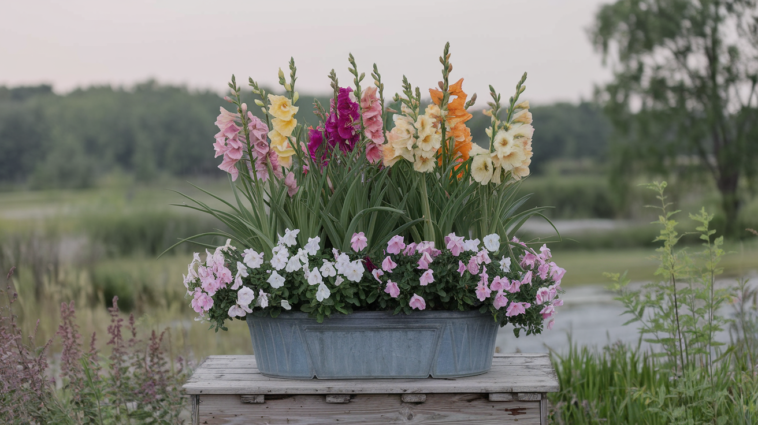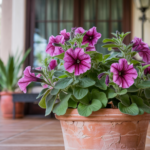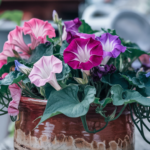Gladiolus, often called “sword lilies,” are striking flowering plants that produce tall, colorful spikes of blooms. While they are commonly grown in garden beds, they can also thrive in containers, making them a fantastic choice for patios, balconies, and small garden spaces.
Growing gladiolus in containers allows you to control their environment, ensuring optimal conditions for beautiful blooms. Here’s a comprehensive guide on successfully growing and caring for gladiolus in containers.
Choosing the Right Container
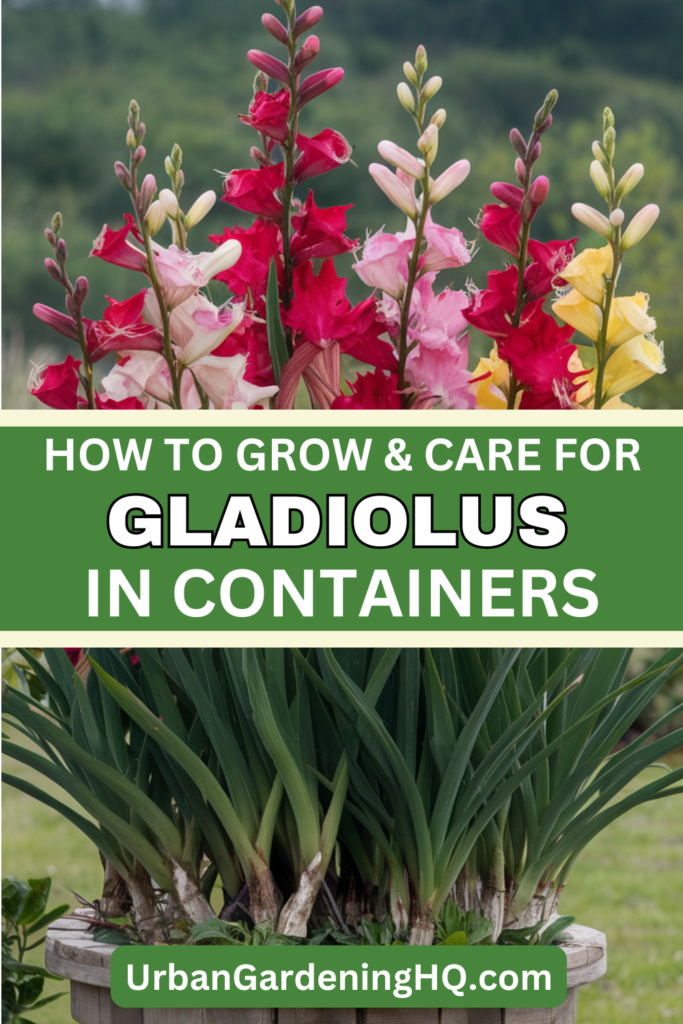
Selecting the appropriate container is crucial for growing healthy gladiolus. Since these plants develop tall flower spikes, they require a sturdy container that can support their height. A pot that is at least 12-16 inches deep and 12 inches wide is ideal, allowing ample room for root development.
Ensure the container has drainage holes to prevent waterlogging, as gladiolus corms (bulbs) are prone to rot in soggy soil. If using a decorative container without drainage, place a plastic liner pot inside or drill holes to improve drainage.
Selecting the Best Soil
Gladiolus thrives in well-draining, nutrient-rich soil. A high-quality potting mix combined with compost or aged manure provides essential nutrients for growth. Avoid using heavy garden soil, as it can retain too much moisture and lead to poor drainage.
For better aeration and drainage, you can mix perlite or sand into the potting soil. A slightly acidic to neutral pH (6.0-7.0) is ideal for gladiolus.
Planting Gladiolus in Containers
When planting gladiolus corms in containers, follow these steps for the best results:
- Choose Healthy Corms: Select large, firm, and unblemished corms, as these will produce the strongest plants and most vibrant blooms.
- Plant at the Right Depth: Bury the corms 4-6 inches deep, with the pointed side facing up. This depth ensures stability as the plant grows taller.
- Spacing: Place corms about 3-4 inches apart to allow room for root expansion and adequate airflow.
- Water Immediately: After planting, water the soil thoroughly to help settle the corms and promote root development.
- Stagger Planting for Continuous Blooms: To enjoy blooms throughout the season, plant new corms every two weeks from early spring to mid-summer.
Light Requirements
Gladiolus thrives in full sun and requires at least 6-8 hours of direct sunlight daily. Place your container in a sunny location such as a balcony, patio, or garden area that receives ample sunlight. If growing indoors, position the pot near a bright south-facing window or use grow lights to supplement light exposure.
Lack of sunlight can result in weak, leggy growth and fewer flowers. If growing in a particularly hot climate, providing some afternoon shade may help prevent excessive heat stress.
Watering and Humidity
Proper watering is essential for healthy gladiolus plants. Water regularly, keeping the soil consistently moist but not soggy. A good rule of thumb is to water when the top inch of soil feels dry.
During hot weather, gladiolus in containers may require more frequent watering, especially if the potting mix dries out quickly. However, avoid overwatering, as excessive moisture can cause corm rot.
Mulching around the base of the plants with organic matter, such as bark chips or straw, can help retain soil moisture and regulate temperature.
Fertilizing Gladiolus
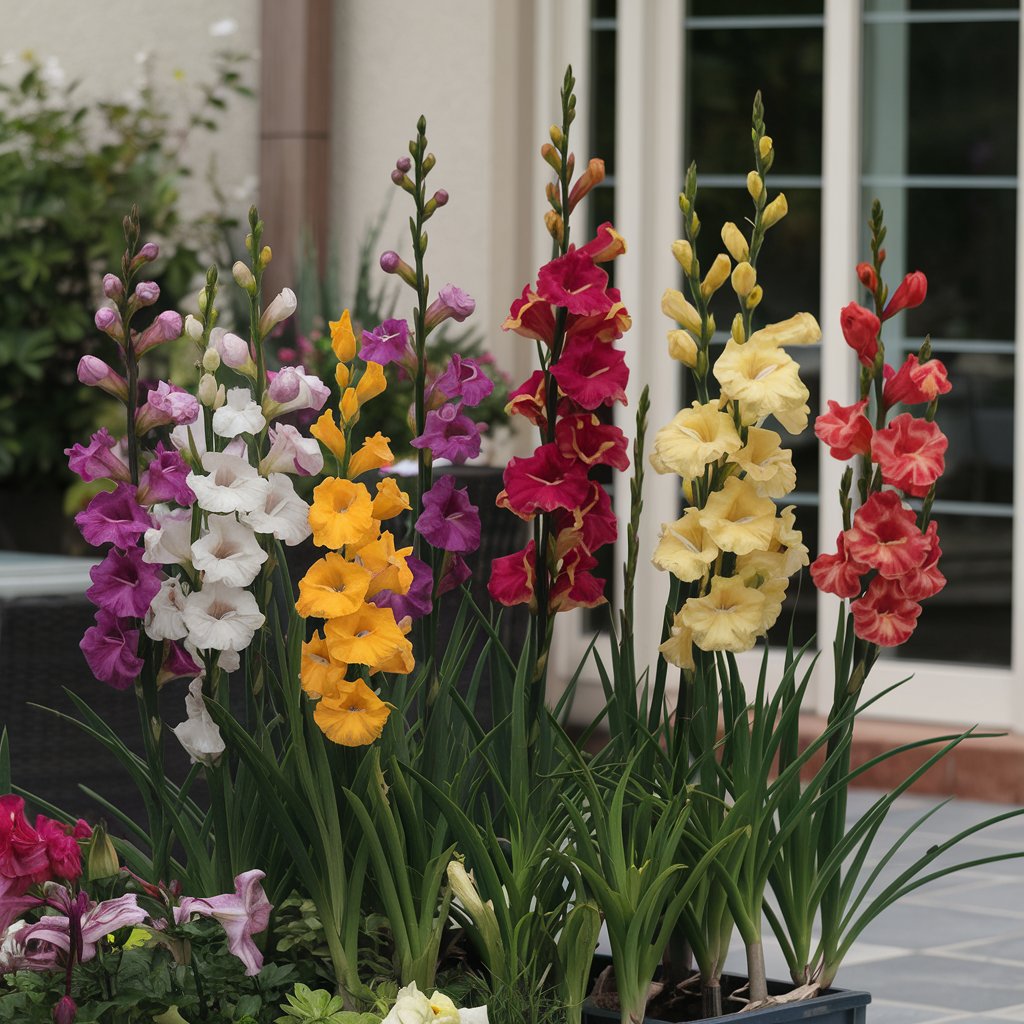
Since gladiolus are heavy feeders, regular fertilization is essential for optimal growth and blooming. Use a balanced, water-soluble fertilizer (such as 10-10-10) every 2-3 weeks during the growing season.
For stronger flower production, switch to a fertilizer higher in phosphorus (such as 5-10-10) once the flower spikes begin forming. Avoid excessive nitrogen, as it can lead to excessive foliage growth at the expense of blooms.
Supporting Tall Stems
Gladiolus plants can reach heights of 2-5 feet, and their tall, slender stems may need support, especially in windy conditions. Insert stakes or plant supports into the container at the time of planting to avoid damaging the roots later.
You can use bamboo stakes, tomato cages, or even decorative trellises to provide stability. Tie the stems gently to the support using soft plant ties or twine to prevent bending or breakage.
Deadheading and Pruning
Deadheading spent flowers encourages continuous blooming and prevents the plant from diverting energy into seed production. Cut off faded blooms by snipping the flower stalks just above the first set of leaves.
Once all the flowers on a stalk have bloomed and faded, cut the entire stem down to the base while keeping the foliage intact. The leaves continue to photosynthesize and provide energy for next season’s corms.
Managing Pests and Diseases
Gladiolus can be susceptible to pests such as aphids, thrips, and spider mites. Regularly inspect your plants and use insecticidal soap or neem oil to control infestations.
Fungal diseases, such as botrytis and rust, can occur in humid conditions or when airflow is restricted. To prevent these issues:
- Ensure good air circulation by spacing corms properly.
- Water at the base of the plant rather than overhead.
- Remove any affected leaves promptly to prevent the spread of disease.
Overwintering Gladiolus Corms
Gladiolus is typically grown as an annual in colder climates (USDA zones 7 and below), as the corms do not tolerate frost. To save your gladiolus for the next season, follow these steps:
- Dig Up Corms: After the foliage yellows and dies back in late fall, carefully dig up the corms.
- Clean and Cure: Remove excess soil and let the corms dry in a warm, well-ventilated area for about a week.
- Store Properly: Place dried corms in a paper bag, mesh sack, or a box filled with dry peat moss or sawdust. Store them in a cool, dark place at around 40-50°F until spring.
For those in warmer climates (zones 8-11), gladiolus corms can be left in the ground or containers year-round with proper mulching for protection.
Repotting Gladiolus
If growing gladiolus in containers for multiple seasons, repotting with fresh soil every year helps replenish nutrients and prevents disease buildup. Remove old corms and replace them with new, healthy corms in early spring.
If using the same container, clean and disinfect it before replanting to eliminate any lingering pests or pathogens.
Conclusion
Growing gladiolus in containers is an excellent way to enjoy their stunning vertical blooms in small spaces. With the right pot, well-draining soil, consistent watering, and proper support, these elegant flowers will brighten up patios, balconies, and gardens throughout the summer.
By following proper care and overwintering techniques, you can keep your gladiolus thriving year after year, ensuring a continuous display of dazzling floral spikes. Whether in a single decorative pot or grouped in a container garden, gladiolus adds beauty, height, and drama to any outdoor space.
